Early Christian Symbolism on Roman Coins.
Return to the main page. Return to Table 2 on the main page.
Coins of Table 2: AD 337-340, after the death of Constantine and before the death of Constantine II.
Image sizes are all proportional to the coin sizes.
Type 2.1 is a variety distinguished by a chi-rho on the standard, struck after the death of Constantine
GLORIA EXERCITVS, two soldiers either side of one standard

Constantine II, struck 337-340
16 mm. 1.57 grams. 6:00.
CONSTANTI-NVS MAX AVG
GLOR-IA EXERC-ITVS
Two soldiers and one standard with chi-rho
Mintmark: ASIS
RIC Siscia 85, page 355, plate 15
This particular portrait looks like Constantine I,
but the coin is of Constantine II.
Not all coins of this type have a portrait looking like this.
[See the next coin.]
None of the Siscia coins are of Constantine I -- even the coins like this one with his portrait and legend are really of Constantine II who assumed the titles of Constantine. This is easy to prove because there are no coins of Sisica with chi-rho minted for the Caesars -- all chi-rho coins of this type for Constantius II (next) and Constans (second next) have obverse legend with AVG. This contrasts with Type 1.12 of Constantina (= Arles) which appears for Constantine as Augustus and all the Caesars and Delmatius.
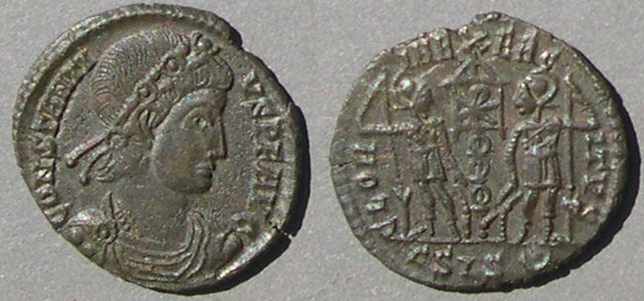
Constantius II, struck 337-340
17-15 mm. 1.29 grams. 11:30
CONSTANTI-VS PF AVG
GLOR-IA EXERC-ITVS
Two soldiers and one standard with chi-rho
Mintmark: ΓSIS<upward crescent with star>
RIC Siscia 91, page 355, plate 15
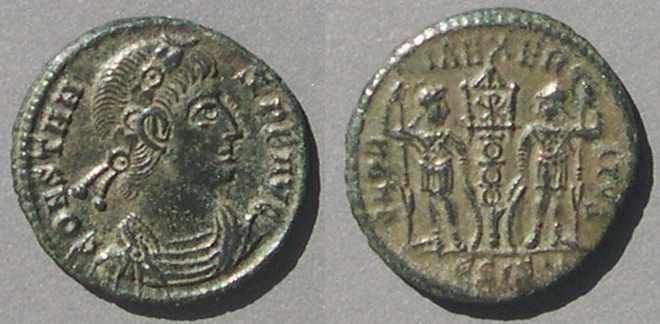
Constans, struck 337-340
16 mm. 1.76 grams. 6:00
CONSTA-NS PF AVG
GLOR-IA EXERC-ITVS
Two soldiers and one standard with chi-rho
Mintmark: ESIS...
RIC Siscia 100, page 355, plate 15
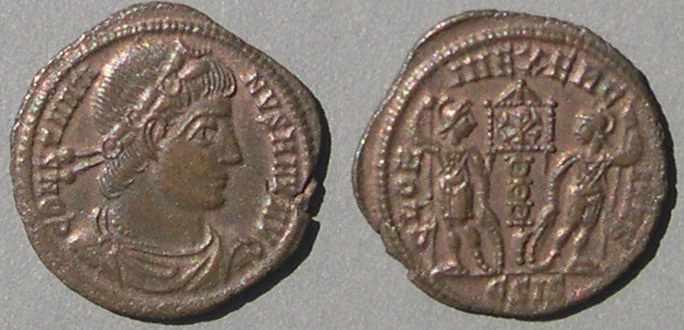 Constantine II, struck 337-340
Constantine II, struck 337-340
17 mm. 1.87 grams. 12:30
CONSTANTI-NVS MAX AVG
GLOR-IA EXERC-ITVS
Two soldiers and one standard with chi-rho
Mintmark: ESIS
RIC Siscia 85, page 355, plate 15
This coin is the same type as the first example above
but the portrait does not look so much like
Constantine I.
____________
From the mint of Lugdunum (Lyons):
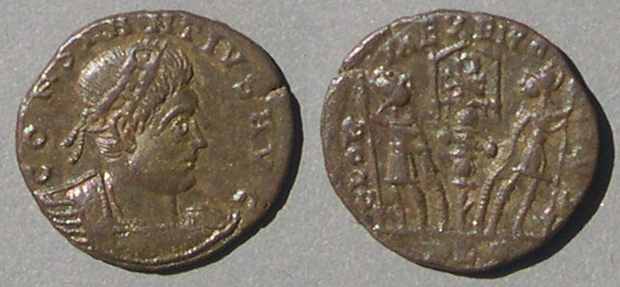 Constantius II, struck 337-340
Constantius II, struck 337-340
15-14 mm. 1.38 grams. 12:00.
CONSTANTVS AVG
GLOR-IA EXERC-ITVS
Two soldiers and one standard with chi-rho
Mintmark: PLG
RIC Lyons 8, page 178

Constans, struck 337-340
16-15 mm. 1.48 grams. 6:00.
CONSTAN-S PF AVG
GLOR-IA EXERC-ITVS
Two soldiers and one standard with chi-rho
Mintmark: AQS
RIC Aquileia 34, page 137
Notes for collectors: The "two soldiers and one standard" type is very common, but usually without a chi-rho. However, a great many Type 2.1 coins from Siscia have a chi-rho on the standard. There are so many that they are among the least expensive of all ancient coins.
Type 2.2 is a variety distinguished by a cross on the standard.
GLORIA EXERCITVS, two soldiers and one standard with cross
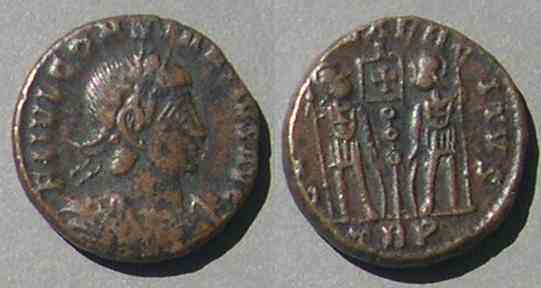
Constantius II, Struck 337-340
13 mm. 2.18 grams. 6:00
Mintmark TRP
RIC Trier 39, page 143
Failmezger 381aCS plate 30, this coin
Note for collectors: Type 2 is a very rare variant of the extremely common basic type. The example above is the published Failmezger piece.
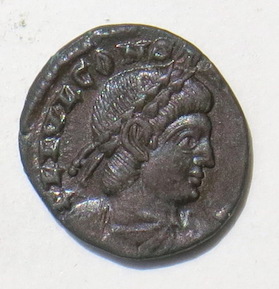

Constans, struck 337-340
14-13 mm. 1.74 grams. 6:30.
Mintmark TRS
RIC VIII Trier 41, page 143.
Failmezger 381


Ancient imitation
14 mm. 1.37 grams. 12:00Mintmark: PLRC ?
RIC has no close prototype.
Trier has cross on standard, but Lyons does not.
Obverse legend: CONSTIII-S PF AV...
Possibly after a prototype of Constans, with the "AN" done with three vertical strokes.
Type 2.3 is a variety distinguished by a cross in the left field.
Theodora/PIETAS ROMANA, Pietas standing left holding child in arms cross in left field
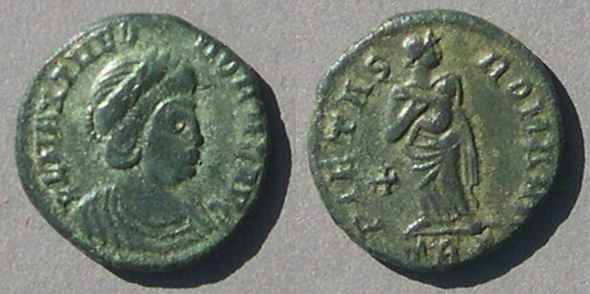 Theodora, second wife of Constantius I
Theodora, second wife of Constantius I
struck 337-340 [RIC] or 335 [Callu]
14 mm. 12:00
FL MAX THEODORA AVG
Mintmark TRP
RIC Trier 43, page 143, plate 1.43
PIETAS ROMANA
Pietas standing right holding child in arms
Cross in field left
Note for collectors: The basic types of Types 2.3 and 2.4 are common and the only AE4 types of Theodora and Helena. However, with the crosses they are rare, but command only a small premium.
Type 2.4 is a variety is distinguished by a cross in the left field.
Helena/PAX PVBLICA, Pax standing left holding branch and transverse scepter, cross in field left.
 Helena, first wife of Constantius I and mother of Constantine the Great
Helena, first wife of Constantius I and mother of Constantine the Great
later Saint Helena
Struck 337-340 [RIC]
15-13 mm. 6:00
Obv: FL IVL HE-LENAE AVG
Mintmark TRS
RIC Trier 42, page 143
PAX PVBLICA,
Pax standing left holding branch and transverse scepter
Cross in field left
Helena was Christian and traveled to the Holy Land. There she discovered and identified the "True Cross" and many of the sites associated with the life of Christ that are now venerated. If anyone has the right to a cross on coins, it is Helena.
Note for collectors: The basic types of Types 3 and 4 are the common and the only AE4 types of Theodora and Helena. However, with the crosses they are rare, but command only a small premium.
Type 2.5. AE4: Constantine in quadriga galloping right, star near forehead,
arm and hand extended outward toward Hand of God above
Obverse legend: DV CONSTANTI-NVS PT AVGG (Divvs [deified] ... Pater [father] of the Augusti)

Constantine deified
16 mm. 1.75 grams. 3:00
Struck 337-340 at Antioch
mintmark: SMANTΓ
no reverse legend
RIC Antioch 37
This is the last Roman coin type to honor a "deified" emperor. It is ironic that the first Christian emperor, one who spend so much effort working on Christian issues, was treated as deified in the Pagan tradition by his Christian sons.
Note for collectors: This type is very common but often not well-struck. Only a fraction have the whole reverse type on the flan and a bold hand.
Continue with coins from the next table, Table 3 (AD 340-348)
after the death of Constantine II in 340 and
before the coinage reform on 348 that introduced the FEL TEMP REPARATIO types.
Return to the previous table (Period of Constantine, to his death in 337)
Return to the main page.



 Constantine II, struck 337-340
Constantine II, struck 337-340 Constantius II, struck 337-340
Constantius II, struck 337-340



 Theodora, second wife of Constantius I
Theodora, second wife of Constantius I Helena, first wife of Constantius I and mother of Constantine the Great
Helena, first wife of Constantius I and mother of Constantine the Great